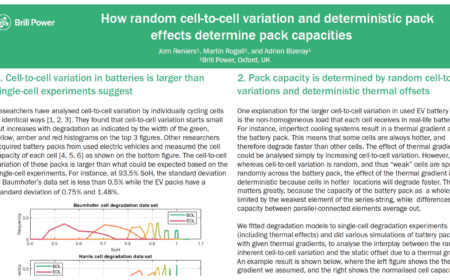Brill Power publishes poster at the Oxford Battery Modelling Symposium

Precipitated by the convergence of the Ukraine crisis and the existing net zero commitments under the Paris Agreement, governments around the world have made energy sovereignty and decarbonisation key policy ambitions.
The leading solution to achieve both national energy independence and the transition to clean energy has been the adoption of renewable power. And it’s happening far faster than expected, with the IEA reporting that ‘total capacity growth worldwide for renewables is set to account for over 90% of global electricity by 2030, overtaking coal as the largest source of electricity generation along the way.’
But despite this momentum there has been a persistent problem with the main renewable vectors of solar and wind power; they are by their very nature, intermittent in generation while demand for electricity is rather more continuous, at least between morning and night.
As a consequence, energy storage has become the critical enabling technology to make renewables work, in particular grid scale batteries that act as a buffer between the intermittency of power generation and the immediacy of demand. But this technology has, until now, been hampered by the cost and durability of large storage investments because batteries degrade with every cycle of their operation.
Operators planning battery storage into grids typically factor in the expected deterioration of the battery, either by oversizing it at the planning stage to provision for its progressive reduction in capacity, or ear-marking capital reserves to add back in capacity at some future waypoint in the system’s lifecycle. If unchecked, experts assess that by 2030, half of battery cell investment in the UK’s utility-scale energy storage will be spent on the replacement of degraded cells1 – at a total cost of $700million1,2.
Not only are the costs of battery replacement eyewatering, but so too are the environmental consequences of this rate of battery replacement. Without intervention the estimated carbon cost of replacing grid batteries by 2030 will be somewhere in the range of 4.3 to 28.8 million tonnes of CO23,4; at its upper limit, this measure of CO2 equates to 150% of the carbon dioxide emitted by UK heavy goods vehicles5. For a solution intended to contribute to a net zero ambition, this battery replacement cost in carbon and dollars is patently not viable.
Thankfully, a solution researched at Oxford University, is now available as a novel technology platform developed by Brill Power to tackle the underlying challenge that causes batteries to degrade. At its heart is a solution to the core problem that every battery pack is, without intervention, limited to the performance of its weakest cell.
Brill’s Battery Intelligence Platform overcomes this limitation by ‘actively loading’ individual cells or modules – that is, charging and discharging each cell or module contingent upon its individual health. This allows all of the available energy from the cells to be used, thereby extending battery lifetime of grid-scale energy storage systems by up to 80% for the most common thermal management approach6.
The significant battery lifetime extension of up to 80% means operators will no longer have to pre-provision for redundancy or plan for in-lifecycle battery replacement. This represents a cost reduction of 29% for a typical system installation while also reducing the carbon costs associated with earlier replacement of batteries by 50%. What’s more, actively managing the battery cycling allows the system to detect and isolate malfunctioning cells, making its operation more stable and safe.
The hardware also comes complete with an integrated power conversion capability which means an existing system can be easily scaled up without the additional cost or complexity of DC/DC converters.
To manage Brill’s breakthrough hardware, the BrillCore, the company has developed the world’s first universal operating system for batteries. BrillOS future-proofs operators by virtue of being agnostic to the battery chemistry, while also enabling over-the-air updates to the system.
Another challenge for large-scale battery systems is knowing and predicting its state of health and performance. BrillAnalytics is Brill’s in-house developed, cloud-based data platform, which provides end-to-end connectivity and insights – from cell to screen. The platform records and computes battery performance data to provide predictive insights that allow the streamlining of maintenance and the optimisation of the battery usage.
At its core, Brill Power’s battery technology advance has created a critical link between renewable power and its capacity to act as an on-demand replacement for legacy power generation and with it, the picture for grid storage batteries becomes clearer.
Sources and assumptions:
1 Timera Energy: Battery investment cycle protects margin downside (2022)
2 Assumptions – Battery cost: $176/kWh, 4h systems (US Department of Energy, 2020)
3 MIT Climate Portal, 2022
4 Assumptions – Deployed capacity: BNEF (2022)
5 UK Department for Transport (2022)
6 Based on lifetime simulations for a 1MWh battery system by J.M. Reniers and D.A. Howey, Applied Energy, 2023